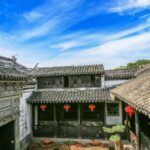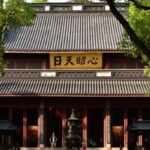Jing’an Temple is located in the bustling commercial district of Jing’an, Shanghai, with convenient transportation. Surrounded by high-rise buildings, it forms a sharp contrast with the tranquil temple. The architectural style of the temple integrates Tibetan temple features, with a silver Buddha in the Mahavira Hall weighing 15 tons, and the jade Buddha in the Moni Hall is much larger than the one in the Shanghai Jade Buddha Temple.
Before entering the temple gate, one can see the high pillar in front of the temple, ‘Zhengfa Jiuzhu Fangzhuang’, which has the four characters ‘Zhengfa Jiuzhu’ inscribed on the front, and the back is inscribed with Su Shi’s ‘Diamond Sutra’. The top is a gilded four-faced lion statue, modeled after the Ashoka Pillar in Sarnath, northern India. After entering the temple gate, there is a large square with a large incense burner made of 15 tons of white copper. Unlike other temples where the main halls are on the central axis, the halls dedicated to Bodhisattvas in Jing’an Temple are connected to the rooms where monks perform their duties, surrounding the square on two levels. Visitors usually start by walking around the square to visit the first level, then proceed to the second level. On the right side of the first level, the Guanyin Hall houses a 6.2-meter-tall thousand-year-old camphor wood Guanyin statue. On the left side, the Moni Hall houses a 3.87-meter-tall jade Buddha of Shakyamuni, which is much larger than the ‘treasure of the temple’ in the Shanghai Jade Buddha Temple, and had to dismantle the temple walls to bring it in due to its size. In the northwest corner of the first level is the Jing’an Pagoda, with five Tibetan-style four-faced pagoda decorations on the top, housing 868 Buddha statues and many esoteric treasures inside, but the pagoda is generally not open to the public, only viewable from the outside. Originally a part of the Han Chinese Exoteric Buddhism, under the leadership of the abbot Chisong, Jing’an Temple gradually leaned towards Tibetan Esoteric Buddhism, which is also reflected in its architectural style, a blend of Han and Tibetan features, particularly evident in the Jing’an Pagoda and the pillar outside the temple inscribed with ‘Zhengfa Jiuzhu’. The south side of the second level is the mountain gate, and the second level is the Hall of the Heavenly Kings. On both sides of the Hall of the Heavenly Kings are the drum tower and the bell tower, unfortunately, they are usually closed, and visitors can only peek inside at the huge red drums and bells through windows or door cracks. On both the east and west sides of the second level, there are many rooms where monks can be seen performing their duties; visitors are advised not to disturb them. The north side of the second level, above the first level’s lecture hall, is the Mahavira Hall, which houses a 15-ton silver Buddha statue. The reverse side of the statue features exquisite and valuable three-dimensional murals, made of various colored gemstones, corals, shells, jade, and pearls, arranged according to color to depict Buddhist scriptures, with gold-foil-adorned lotus petal-shaped frames surrounding them. The halls of Jing’an Temple are topped with copper tiles, the four-faced lion statues on the high pillars in front are golden, and the top of the pagoda behind the temple is gilded. From a distance, the entire temple is a sea of golden roofs, particularly eye-catching, shining brightly in the sunlight.Jing’an Temple is open all year round from 07:30 to 17:00.

Essential Tips:









